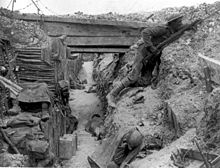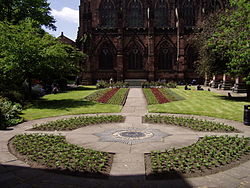- Cheshire Regiment
-
The Cheshire Regiment 
Cap badge of The Cheshire RegimentActive 1689-2007 Country United Kingdom Branch Army Type Infantry Role Light Infantry Size One battalion Part of Prince of Wales' Division Garrison/HQ 1st Battalion - Catterick Nickname The Old Two-twos
The Young Buffs
The Peep of Day Boys
The Lightning Conductors
The Red Knights
The Specimens
TwosMotto Ever Glorious Colors Cerise and Buff March Quick - Wha Wadna Fecht for Charlie
Slow - The 22nd Regiment 1772Engagements See honours list Commanders Ceremonial chief HRH The Prince of Wales, KG, GCB, KT, ADC(P) Colonel of
the RegimentBrigadier A.R.D. Sharpe OBE Insignia Tactical Recognition Flash  A British trench near the Albert-Bapaume road at Ovillers-la-Boisselle, July 1916 during the Battle of the Somme. The men are from A Company, 11th Battalion, The Cheshire Regiment.
A British trench near the Albert-Bapaume road at Ovillers-la-Boisselle, July 1916 during the Battle of the Somme. The men are from A Company, 11th Battalion, The Cheshire Regiment.
The Cheshire Regiment was an infantry regiment of the British Army, part of the Prince of Wales' Division. The regiment was created in 1881 as part of the Childers reforms by the linking of the 22nd (Cheshire) Regiment of Foot and the militia and rifle volunteers of Cheshire. The title 22nd (Cheshire) Regiment continued to be used within the regiment.
The 22nd Foot was raised by the Duke of Norfolk in 1689 and was able to boast an independent existence of over 325 years, being one of five line infantry regiments never to have been amalgamated in its history; Up to 2006, it shared this claim with:
- The Royal Scots
- The Green Howards
- The Royal Welch Fusiliers
- The King's Own Scottish Borderers
On September 1, 2007, the Cheshire Regiment was merged with other regiments to form part of the Mercian Regiment, becoming 1st Battalion The Mercian Regiment (Cheshire)[1]
Contents
History
In 1689, Henry, Duke of Norfolk, raised a regiment on the little Roodee at Chester, in an effort to resist any attempt by James II to re-take the English throne. For the early part of its formation, the regiment was known by the name of the current Colonel-in-Chief, later becoming known as the 22nd Regiment of Foot. In the same year that it was raised, the regiment saw its first action as part of a British force sent to Ireland under the command of General Frederick Schomberg, 1st Duke of Schomberg, taking part in the siege and capture of Carrickfergus. In 1690, the 22nd fought in the Battle of Boyne, and in 1691 at the Battle of Aughrim. The regiment continued to serve as a garrison in Ireland from this point until 1695, when it was sent to the Low Countries for a short time before returning to its duties in Ireland.
In 1702, the Regiment sailed to Jamaica, spending the next twelve years in combat duties against the French and native population, both on land and at sea.
In 1726 the Regiment was posted to Minorca where it remained for the next 22 years, although a detachment was present at the Battle of Dettingen in 1743, during the War of the Austrian Succession.
By 1751 the Regiment had become the 22nd Foot, having previously been called after its successive colonels. In 1758 it formed part of Lord Amhest's expedition against the fortress of Louisberg in French Canada. The following year the Regiment took part in General Wolfe's victory over the French at Quebec. The 22nd Foot received two battle honours for taking part in the capture of Martinique and the British expedition against Cuba during 1762.
After home service the Regiment was sent to America in 1775. Having embarked in advance of the rest of the Regiment at the request of Colonel Gage, Lt. Col. Abercrombie arrived in Boston just before the Battle of Bunker Hill, where he was killed in action. The Regiment later evacuated from Boston to Halifax and then onto the New York and New Jersey campaigns of 1776. Its Light Infantry Company participated in the Philadelphia Campaign of 1777 and later the Southern Campaigns in the 1780s, eventually surrendering with Cornwallis at Yorktown. The Battalion Company's occupied Newport Rhode Island, participating in the Battle of Rhode Island, eventually returning to New York City in 1779 and surrounding territory where the bulk of the Regiment would remain until the end of the War, participating most notably at the First Battle of Springfield in early June 1780.
Although the County designation existed as early as 1772, the Regiment was retitled The 22nd (Cheshire) Regiment of Foot in 1782, the Regiment served in the West Indies from 1793, taking part in expeditions against Martinique, St Lucia, Guadeloupe and St Domingo. Between 1800 and 1803 the 22nd was posted to South Africa, then moving to India where it suffered heavy losses during the assault on Bhurtpore (1805). In 1810 the Regiment took part in the occupation of Mauritius where it remained in garrison until 1819.
In 1843 the Regiment gained the battle honours of or Meeanee, Hyderabad and Scinde during further Indian service.
As one of the older regiments of British line infantry already having two battalions, the regiment was not merged with another line regiment by the Cardwell reforms of 1881. The reforms added the following units:
1st Royal Cheshire Light Infantry Militia
2nd Royal Cheshire Militia
1st Cheshire RVC
2nd (Earl of Chester's) Cheshire RVC
3rd Cheshire RVC
4th Cheshire (Cheshire and Derbyshire) RVC
5th Cheshire RVC
Its recruiting area was confirmed as being the County of Cheshire.Both battalions of the Regiment served in Burma between 1887 and 1891, while the 2nd Battalion saw active service in South Africa in 1900.
On 24 August 1914 the 1st Battalion suffered 771 casualties at Audregnies in France during the closing stages of the Battle of Mons. The reconstituted battalion served throughout World War I on the Western Front, winning 35 battle honours. Other battalions served at Gallipoli, in Palestine and on the Western Front. Total losses to the Regiment during 1914-18 were 8,420 dead.
In 1939-40 the 2nd Battalion of The Cheshires served in France before being evacuated from Dunkirk. The 1st Battalion fought in North Africa at Tobruk and subsequently took part in the crossing of the Rhine in March 1945. The 2nd Battalion took part in the D Day landings in 1944, while the 6th and 7th Battalions fought in Italy.
During the post-war years the Regiment served in Palestine, Egypt, Cyprus, Malaya, Singapore, Hong Kong, Bahrein, Belize, Berlin, West Germany, and Northern Ireland. In 1982, 8 Cheshire's were killed in the Droppin Well bombing. It celebrated its Tercentenary in 1989, as one of only two English county infantry regiments never to have been amalgamated - retaining a distinct identity during 300 years of service .
Recent history
Between 1986 and 1988, the 1st Battalion was posted to Caterham as a public duties battalion. This was the first time that a line infantry unit had been posted as such - before this, although line infantry battalions had performed public duties, this had only been for brief periods. Amongst the duties performed was the mounting of the Queen's Guard at Buckingham Palace.
.
Reorganisation of the British Army
In 2004, as a part of the restructuring of the infantry, it was announced that the Cheshire Regiment would be amalgamated with the Staffordshire Regiment and the Worcestershire and Sherwood Foresters to form the new Mercian Regiment. In the August of 2007, the regiment moved to Catterick, simultaneously being renamed as the 1st Battalion, Mercian Regiment (Cheshire), in the light infantry role. The regiment resides in Marne Barracks, which it shares with 5th Regiment Royal Artillery.
Alliances
 Canada - 2nd Battalion, The Nova Scotia Highlanders (Cape Breton)
Canada - 2nd Battalion, The Nova Scotia Highlanders (Cape Breton) India - 5th Battalion (Napiers), The Rajputana Rifles
India - 5th Battalion (Napiers), The Rajputana Rifles Royal Navy - HMS Albion
Royal Navy - HMS Albion
Battle honours
The regiment was awarded the following battle honours. Those from the two World Wars that are emblazoned on the Queen's Colour are indicated in bold.
- Louisburg, Martinique 1762, Havannah, Meeanee, Hyderabad, Scinde, South Africa 1900-02
- The Great War (38 battalions): Mons, Le Cateau, Retreat from Mons, Marne 1914, 18, Aisne 1914, 18, La Bassee 1914, Armentieres 1914, Ypres 1914 '15 '17 '18, Nonne Bosschen, Gravenstafel, St. Julien, Frezenberg, Bellewaarde, Loos, Somme 1916 '18, Albert 1916 '18, Bazentin, Delville Wood, Pozieres, Guillemont, Flers-Courcelette, Morval, Thiepval, Le Transloy, Ancre Heights, Ancre 1916, Arras 1917 '18, Vimy 1917, Scarpe 1917 '18, Oppy, Messines 1917 '18, Pilckem, Langemarck 1917, Menin Road, Polygon Wood, Broodseinde, Poelcappelle, Passchendaele, Cambrai 1917 '18, St Quentin, Bapaume 1918, Rosieres, Lys, Estaires, Hazebrouck, Bailleul, Kemmel, Scherpenberg, Soissonais-Ourcq, Hindenburg Line, Canal du Nord, Courtrai, Selle, Valenciennes, Sambre, France and Flanders 1914-18, Italy 1917-18, Struma, Doiran 1917 '18, Macedonia 1915-18, Suvla, Sari Bair, Landing at Suvla, Scimitar Hill, Gallipoli 1915, Egypt 1915-17, Gaza, El Mughar, Jerusalem, Jericho, Tell 'Asur, Palestine 1917-18, Tigris 1916, Kut al Amara 1917, Bagdad, Mesopotamia 1916-18
- The Second World War: Dyle, Withdrawal to Escaut, St Omer-La Bassée, Wormhoudt, Cassel, Dunkirk 1940, Normandy Landing, Mont Pincon, St. Pierre La Vielle, Gheel, Nederrijn, Aam, Aller, North-West Europe 1940, '44-45, Sidi Barrani, Capture of Tobruk, Gazala, Mersa Matruh, Defence of Alamein Line, Deir el Shein, El Alamein, Mareth, Wadi Zeuss East, Wadi Zigzaou, Akarit, Wadi Akarit East, Enfidaville, North Africa 1940-43, Landing in Sicily, Primosole Bridge, Simeto Bridgehead, Sicily 1943, Sangro, Salerno, Santa Lucia, Battipaglia, Volturno Crossing, Monte Maro, Teano, Monte Camino, Garigliano Crossing, Minturno, Damiano, Anzio, Rome, Gothic Line, Coriano, Gemmano Ridge, Savignano, Senio Floodbank, Rimini Line, Ceriano Ridge, Valli di Comacchio, Italy 1943-45, Malta 1941-42
- 4th Battalion: South Africa 1901-02
- 5th, 6th Battalions: South Africa 1900-02
See also
References
- Cannon, Richard (1849). Historical Record of the Twenty-Second, or the Cheshire Regiment of Foot. London: Parker, Furnivall and Parker. http://books.google.co.uk/books?id=Gt0QAAAAYAAJ.
External links
Categories:- Infantry regiments of the British Army
- Battalions of the British Army
- 1689 establishments
- Military units and formations established in 1689
- Regiments of the British Army in World War II
- Regiments of the British Army in World War I
- Regiments of the British Army in the American Revolutionary War
- Military history of Cheshire
Wikimedia Foundation. 2010.


